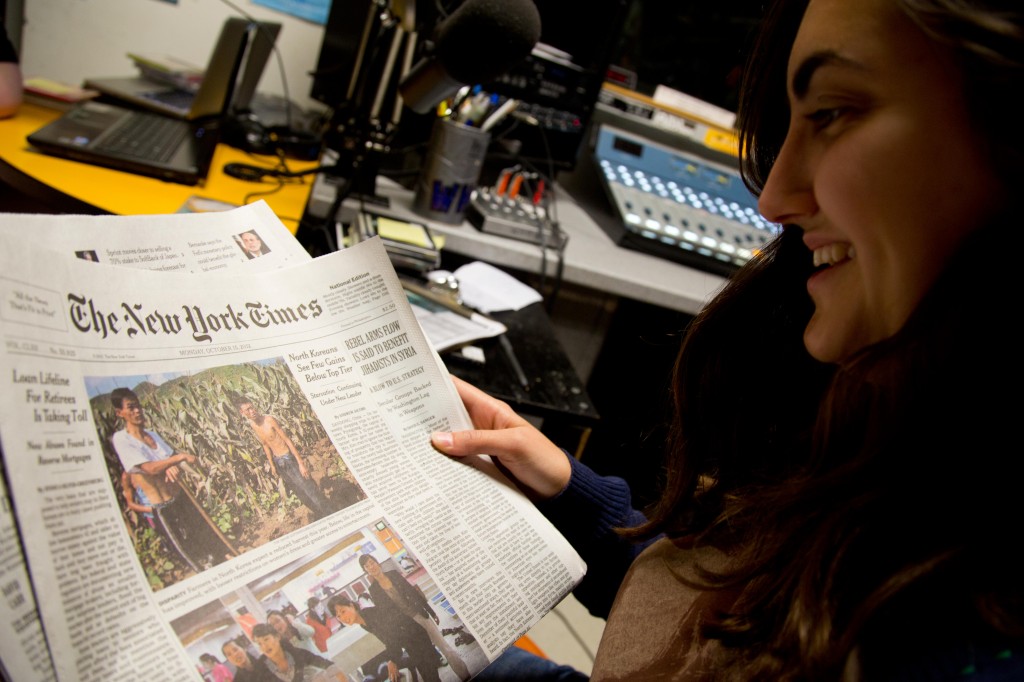
After weeks of scrambling, the Student Association vice president for academic affairs (VPAA) has secured enough funding to keep an abbreviated version of last year’s New York Times Readership Program on campus for the remainder of the academic year, although he is still awaiting decisions from the provost’s office and several campus community governments about whether they will choose to contribute.
Beginning last week, 200 copies of The New York Times were delivered to campus every weekday — 200 fewer than were delivered last year. At the time, VPAA Aaron Ricks had only raised enough money to fund the program into next month. However, recent contribution promises from various offices, most notably a $5,500 pledge from the office of campus activities over the weekend, suggest he can now maintain the program for the remainder of the year.
“How things are going, it’s looking like 200 copies for the rest of the year is doable,” he said.
As he secures more money, Ricks said he would like to increase distribution back to 400 copies.
“I can basically increase the distribution as much as I want whenever I want, with like two weeks heads-up, and so I’m going to do what I can to get as many copies as possible,” he said.
With the addition of the $5,500 from the office of campus activities, Ricks has secured a total of $11,135, about $2,000 shy of Ricks’ estimate for the annual cost for 200 copies per day and $15,000 shy of the cost for 400 copies per day.
“It’s 60 cents per copy, per day. For 200 copies, that’s $120 per day. Bump that up to $240 for 400 copies,” Ricks said.
The provost’s office and the Off-Campus Community Council (OC3) have yet to contribute to the program. In his initial proposal, Ricks asked them for $5,500 and $4,000, respectively, which would account for roughly 37 percent of his total proposal.
Ricks said he pitched his proposal to Provost Donald Nieman roughly a month ago, but has yet to hear back from him.
“I’m going to continue to try to contact him,” Ricks said. “He’s a very busy person, I understand that, but I feel very strongly about this program.”
Nieman did not respond to multiple calls and emails from Pipe Dream inquiring about his decision.
OC3 asked Ricks to go over his proposal again before they would commit to fund the program. Ricks will address the council’s concerns about the accessibility of the paper to off-campus students at a meeting this evening.
“Last year there was a percentage — maybe it was 40 percent, maybe it was 50 percent — of the papers were being placed in the Union and around those locations so that off-campus students would be benefited in proportion to the amount they had contributed,” said David Blaire, president of OC3. “This year, with there being no food court, traffic in the Union is much less substantial than it was last year.”
Blaire suggested that alternatives to placing papers in the University Union would be Einstein Bros. Bagels or the University Union bus stop.
OC3 represents slightly less than half of the undergraduate population at BU, and the $4,000 Ricks asked of the council is significantly more than he asked of the other community councils. The $4,000 is roughly 40 percent of the total contribution he sought from the SA.
“I split up the cost of that roughly $10,000 between all the communities, and I did it proportionally, so OC3 has clearly the largest budget,” Ricks said.
He assured that he would provide copies of the Times to all the communities, but he would make an extra effort to make the papers accessible to communities whose governments fund the program.
“I will get as many copies as possible, with special consideration for community governments that gave what I proposed,” Ricks said. “I really see this as a service to the communities, and while I will service all the communities no matter what, the main communities have their own budgets and when they give it to this program they really expect to have newspapers there.”
Although Blaire recused himself from OC3’s decision because of a conflict of interest, he remained confident that the council would contribute at least some money to the program.
“Personally, I am in favor of the program,” said Blaire, a senior majoring in mathematics. “I can’t guarantee anything, of course, but I do think the council will give a significant portion of the money, hopefully all of it.”
Thus far, College-in-the-Woods, Hinman College and Dickinson Community have promised a combined $1,635, in addition to $2,000 Ricks contributed from his own budget.
Sodexo promised $2,000 to the Times Readership Program from an annual allocation to contribute to student programming, according to Bob Griffin, district marketing manager for Sodexo.
Ricks said if he were unable to raise sufficient money to fund the program in full, he would be willing to seek funding from the Student Association Financial Council.
“FinCo supported the program last year,“ Ricks said. “I’m confident that I could get them to support the program because I’ve done everything I’ve needed to, I’ve tried to secure as much funding as possible outside, I’ve always considered FinCo a last resort for student groups.”


